Arizona man develops watermelon-sized tumor on his neck that began as a ‘little pimple’ – and now feels like his face is being ‘ripped off’
An Arizona man’s neck tumor, which had been growing for nearly two decades, grew so large that he had difficulty eating, bathing and even turning his head from side to side.
Tim, a 62-year-old from Scottsdale, had a 5-pound tumor growing on the right side of his face and neck.
While the mass started out as “a little pimple near my ear,” Tim said it continued to grow for 16 years, evolving from a golf ball to a tennis ball.
Eventually it grew so large that it started putting pressure on his ear, jaw, neck and throat.
Due to its size, the tumor deformed Tim’s face, causing him to pull and stretch his ear, jaw, cheek and eye. He had headaches every day and some movements made his face seem to ‘tear’.
He could only eat from the left side of his mouth and had been eating his meals standing up, otherwise the growth would crash into the table and crash into his food.
Tim, a 62-year-old from Scottsdale, Arizona, had a 5-pound tumor growing on the right side of his face and neck
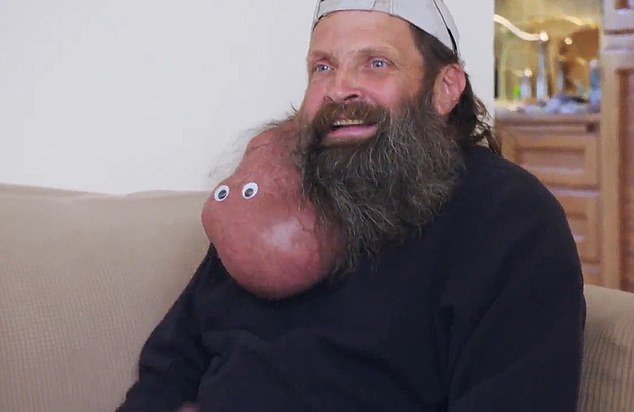
Tim often used humor as a “security blanket” and to make people more comfortable around him and his growth
Tim was never able to remove the tumor because he had no health insurance or the money to finance the surgery himself.
But when head and neck surgeon Dr. Ryan Osborne contacted him, Tim was given hope that he could finally live a normal life.
He said that on the latest episode of TLC’s Take my tumor: ‘Hopefully Doctor Osborne is fully capable of removing the beast. You have to put your trust in someone and… I give Dr. Osborne permission [do his] magic.
“At the end of the day, I just want to be semi-normal and I don’t often feel that way.”
Tim’s tumor first appeared in 2007, when he was 46.
He thought it was a pimple and squeezed it to see if it would pop. When nothing happened, Tim continued.
Then it grew to the size of a pea and he asked someone else to try to destroy it. Yet nothing happened.
One day he woke up and it was the size of a bouncy ball: ‘One day you look in the mirror and think, “oh, he’s gotten bigger.”‘
When he turned to the internet looking for answers, he said all the information added up for a sebaceous cyst, the most common type of skin cyst.
This type of cyst is a non-painful bump under the skin that grows slowly. It is usually harmless and can occur on the face, neck, scalp, back or groin area.
The growths are quite common, affecting at least 20 percent of adults. They can form when a sebaceous gland – a microscopic gland connected to the hair follicle that secretes an oily or waxy substance – becomes damaged or blocked.
Most of these cysts do not require treatment and should be left alone and kept clean.
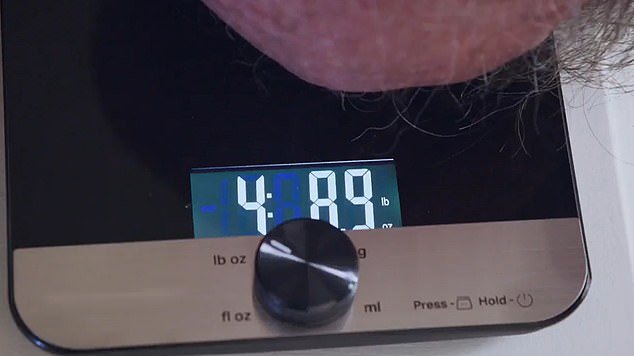
Tim’s growth has been weighed several times, with weights ranging from 4 pounds to almost 6 pounds
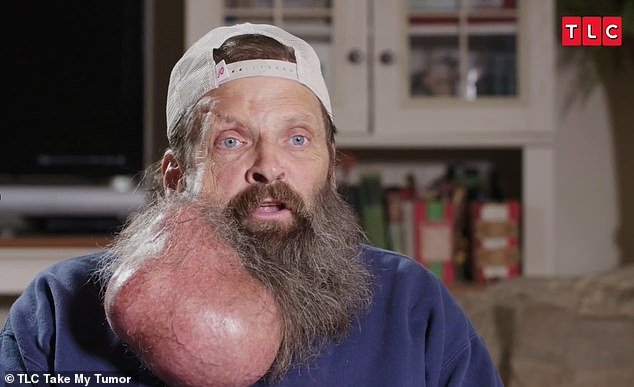
The technician was never able to remove his tumor because he had no health insurance or the money to pay for the surgery himself
However, if the growth causes discomfort, a doctor can remove it with local anesthesia.
Over the years, Tim used humor as a defense mechanism and “security blanket” to deal with his “friendly little tumor” and make people feel less uncomfortable with him and his growth.
But the 4- to 6-pound mass still hindered his life.
The mechanic said he had to lift the tumor over his shoulder to turn his head while driving and that the tumor got in the way when he tried to maneuver under cars to service them.
All his clothes were stretched to fit over the growth and he often didn’t get enough sleep, having to position himself on his left side with his right elbow under the tumor to keep the weight from crushing his neck.
But with the help of Dr. Osborne got Tim to remove the growth, which a friend nicknamed “Little Timmy.”
So he flew to the surgeon, a Los Angeles-based head and neck surgical oncologist and director of the Osborne Head and Neck Institute.
While the two were previously video chatting, Dr Osborne said: ‘To truly appreciate the magnitude of this tumor you have to see it with your own eyes.’
After examining the growth, the doctor said he suspected the tumor came from Tim’s parotid gland, a gland that makes saliva.
Having tumors in this gland is not uncommon, but they are usually the size of a walnut. One as large as Tim’s is “unusual” and looked more like a watermelon, Dr Osborne said.
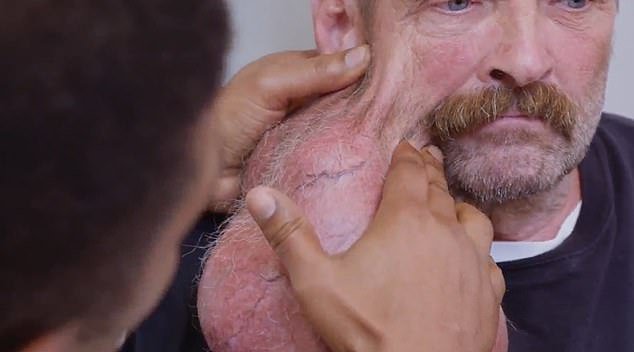
While the two were previously video chatting, Dr Osborne said: ‘To truly appreciate the size of this tumor you have to see it in person’

Dr. Ryan Osborne, a Los Angeles-based head and neck surgical oncologist and director of the Osborne Head and Neck Institute, expressed concern about the nerves that pass through the tumor
Although the surgeon felt comfortable removing the mass, he expressed concern about tampering with the facial nerves that run through it – cutting the wrong ones could result in facial paralysis.
Whatever happens, Dr. Osborne would have to cut a major nerve that supplies sensation to the right ear.
After surgery, there was also the possibility of a large fissure in the side of Tim’s face.
Additionally, the doctor told Tim that even if the surgery were successful, it could still take six months for him to regain full function and feeling in his face.
Although Tim was ‘not too happy’ that he could have slight deformities in his face, he was still convinced that he wanted the tumor gone.
The most worrying detail that Dr. However, Osborne told Tim there was a small chance that the mass could be cancerous.
Although his instincts told him it was benign, because it had been growing for so long, there was a chance that the cells had mutated and become cancerous.
Either way, the tumor had to be removed, and that would happen soon, Dr. Osborne said.
Tim said: ‘It’s the first time anyone has actually said there is a possibility it is cancer. It casts a bit of a shadow over the parade, but I can’t change it.
‘And to find out whether there is cancer there, the tumor still has to be removed.’
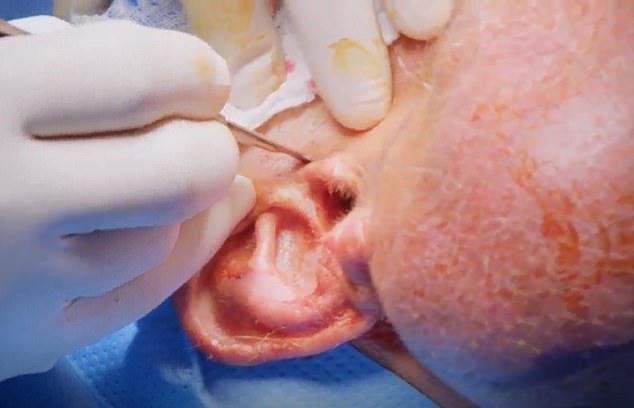
Dr. Osborne and his colleague, plastic surgeon Dr. Jason Hamilton, operated on Tim’s face and neck for nearly five hours

Tim’s surgery was successful and he retained all facial movement and had no deformities
Two days later, Dr. Osborne and his colleague, plastic surgeon Dr. Jason Hamilton, operated on Tim’s face and neck for almost five hours.
During the operation, Dr. Osborne identify and avoid major facial nerves. He removed the entire mass and Dr. Hamilton was able to reconstruct Tim’s cheek without any cavity.
Tim woke up and could still smile and move his whole face.
A week later, Dr Osborne told Tim that the pathology was ‘as good as you can get’.
The tumor was completely benign and showed no signs of cancer. The results showed that the growth was “consistent with a benign parotid tumor called a pleomorphic adenoma.”
Pleomorphic adenomas are the most common type of salivary tumor, accounting for 70 to 80 percent of benign salivary gland tumors and are especially common in the parotid gland.
Each year, these growths account for two to 3.5 cases per 100,000 people, the NIH reports.
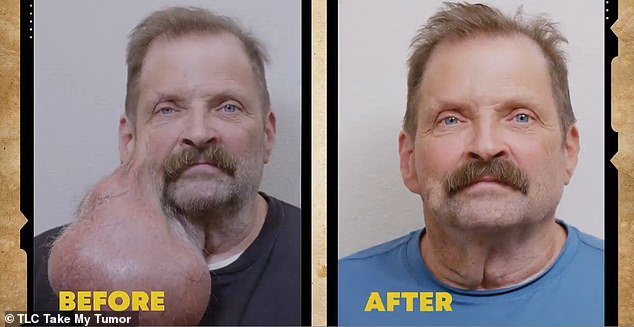
Since the tumor removal, Tim has been able to put on his shirts properly, eat with his whole mouth, drive a car without lifting his tumor to turn his head and has had no headaches since the morning of surgery

The technician said, “It feels great” now that the tumor is gone and he is ready to move on with his life
Seven weeks after his surgery, Tim went outside without fear of people staring or laughing at him, and he was able to shave for the first time in 20 years.
He said: ‘I feel lighter since the operation. I have had zero pain. It was much easier than I expected… It feels fantastic.
“When the tumor was there, damn, that thing was ugly. It’s good that it’s gone. Sixteen years was long enough. Everywhere I go, everyone is very happy for me.’
Now he can put on shirts properly, eat with his whole mouth, drive a car without lifting his tumor to turn his head and has not had a headache since the morning of surgery.
He can also work well on customers’ cars without the tumor getting in the way.
Now that the tumor is gone, Tim said he can start living his life.
He added: ‘I have to say now: ‘I don’t have a tumor anymore. You’re back to normal, so now move on in life. Let’s go.”‘
Take my tumor airs Wednesdays at 10/9c on TLC.
